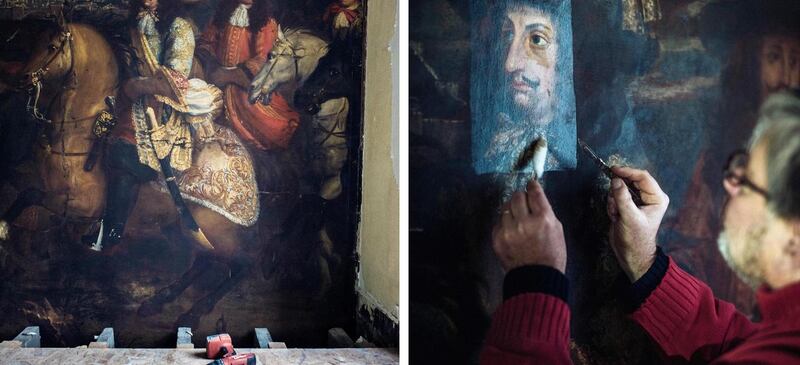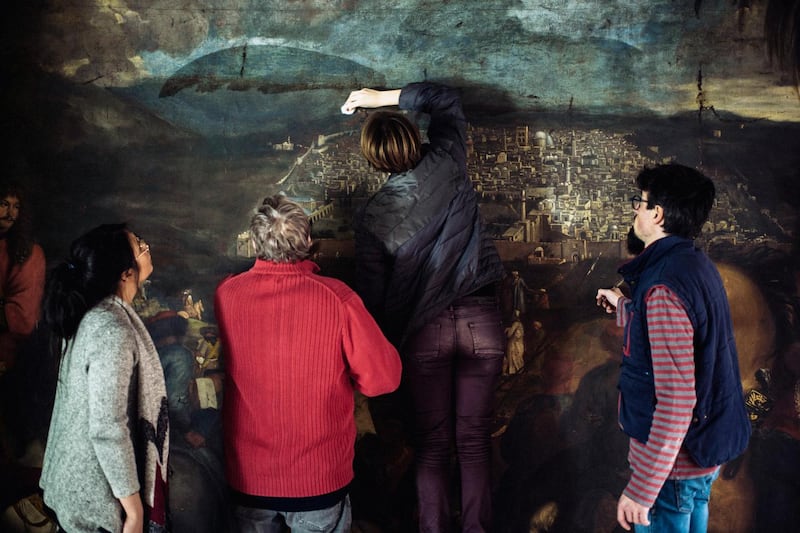Alex Bolen, the chief executive of Oscar de la Renta, planned to have his new store in Paris open around this week, just in time for the couture shows. He planned to have a presence in the city even if he did not have a show. He had it all figured out.
Then, last summer, in the middle of renovations, Bolen got a call from his architect, Nathalie Ryan. "'We made a discovery,'" he remembers her saying. On the other end of the phone, Bolen cringed. The last time he received a call like that about a store, their plans to move a wall had to be scrapped because of fears the building would collapse. He asked what, exactly, the discovery was.
Sometimes when you work on castles you find something, but usually it's a hidden fireplace or, in Italy, maybe a fresco. But in an apartment? In a store?
“You have to come and see,” she told him. So, gritting his teeth, he got on a plane from New York. Ryan took him to the second floor of what would be the shop, where workers were busily clearing out detritus, and gestured towards the end of the space. Bolen, she says, blinked. Then he said: “No, it’s not possible.”
Something had been hidden behind a wall, and it was not asbestos. It was a 3m-by-6m oil painting of an elaborately coiffed and dressed 17th-century marquis and assorted courtiers entering the city of Jerusalem. “It’s very rare and exceptional, for many reasons,” says Benoît Janson, of the restoration specialists Nouvelle Tendance, who is overseeing work on the canvas. Namely, “its historical and aesthetic quality and size”.
Be careful what you wish for
Bolen had looked for a store in Paris for a long time. In the early 1990s the company had a small boutique in the city during de la Renta’s tenure as couturier of Balmain, but the boutique closed after he left the brand in 2002. (He died in 2014.)
In 2017 Bolen was offered the former Reed Krakoff store on Rue de Marignan, a diagonal side street off the luxury Avenue Montaigne, which terminates on one end at L’Avenue, the high-fashion canteen.
The interior, designed by Jeang Kim and Will Kim of Oro Studio, would feel less like a big white box than a home for "young people who had just moved into their grandmother's grand apartment", according to Jeang Kim (who is also the sister of Oscar de la Renta's co-creative director Laura Kim; she is not related to Will Kim).

Not long after the demolition began, a discovery was made. A workman, tearing down the dropped ceiling in the last room on the second floor, said there was something “strange”. That would be a panelled ceiling that had been underneath the visible one, composed of 29 inset squares, eight of them painted with different heraldic seals, and a central diamond. Dating from the mid-19th-century, they were well preserved, as they had been recessed within the coffers of the ceiling.
Still, although that was an interesting find, it was not unprecedented in a building of that age. It was when workers began removing the chipboard along the side and a chunk of the wall came off, too, that things got very interesting. “Oh my God, it was, Wow,” says Ryan, who was the in-house architect for Dior for many years and opened her own company, Kirei Studio, in 2010. Behind the wall a single painting, dark with age, ran from end to end. “Sometimes when you work on castles you find something, but usually it’s a hidden fireplace or, in Italy, maybe a fresco,” Ryan says. “But in an apartment? In a store?” She had never seen anything like it.
“Everyone freaked out,” Jeang Kim says. “It was like finding a mummy. I turned off my phone immediately and just looked at it. Nothing like this had ever happened in my work before.”
A whodunnit
In the game of six degrees of separation, this was a good one: Bolen’s mother-in-law, Annette de la Renta, had cousins (via her mother, Jane Engelhard) who had married into the de La Rochefoucauld family, storied members of the French aristocracy. One of those family members happened to live across the street from the new de la Renta boutique.
So when the painting was found, and it became clear Bolen would have to talk to the building's owners, whom he had never met (the lease had been negotiated through a broker), his relative was able to make the introductions. Another de La Rochefoucauld, who happened to work at the Louvre, got a recommendation for an art historian: Stephane Pinta of the Cabinet Turquin, an expert in old-master paintings.
How the painting ended up glued to that wall, no one knew, nor why it was covered up. There was speculation that maybe it happened during the second World War, given the setting
Pinta determined that the painting was an oil on canvas created in 1674 by Arnould de Vuez, a painter who worked with Charles Le Brun, the first painter to Louis XIV and designer of interiors of the Château de Versailles. After working with Le Brun, de Vuez, who was known for getting involved in duels of honour, was forced to flee France and ended up in Constantinople.
Pinta traced the painting to a plate that was reproduced in the 1900 book Odyssey of an Ambassador: The Travels of the Marquis de Nointel, 1670-1680, by Albert Vandal, which told the story of the travels of Charles-Marie-François Olier, marquis of Nointel and Angervilliers, Louis XIV's ambassador to the Ottoman court. On page 129 there is a rotogravure of an artwork depicting the marquis arriving in Jerusalem with great pomp and circumstance – the painting on the wall.
But how it ended up glued to that wall, no one knew, nor why it was covered up. There was speculation that maybe it happened during the second World War, given the setting. It could be “a fog-of-war issue”, Bolen says. What everyone did know was that it would be dangerous to move because of how the painting had been attached to the wall: backed by gauze and glued on. And, Bolen says, his wife, Eliza, told him, “If you move that painting, you will have 100 years of bad luck.” He thought she was probably right.
The next mystery
Instead Bolen reached an agreement with the building’s owners: he would restore the painting if they agreed to let it remain in the store while the store was a tenant. (The initial lease is for 10 years.) Janson got to work in late November.
“It was very dark, because of all the overpaint from earlier restorations and varnish,” Janson says. For the past two months a team of three to five people have laboriously swabbed away some of the varnish to allow the colours to come through. They hope to be finished by May, Janson says, although Bolen believes it will be sooner than that.

Slowly, details that confirm the painting’s provenance have begun to emerge: the mosque, the Western Wall, the elaborate brocades of the visiting Frenchmen.
The discovery demanded something of an interior rethink as well as some practical changes. Jeang Kim has been haunting auctions for furniture from different periods to link past to present, including Marcel Breuer chairs and pieces from Pierre Bergé’s estate.
“We’re not going to put a wall of dresses in front,” Ryan says. Security will be increased, and the 10 floor-to-ceiling windows on the second floor equipped with treated glass. The plan is to open in late spring.
In the meantime, Bolen has not given up the search. “I need to get a heraldic expert in to look at the ceiling,” he says, sifting through photographs and pointing at some of the shields. “That one has three stars, a royal crown – and fish?” He looks at another one. “What do those three stars mean?” he wonders. “I don’t know. But that’s worth finding out.” He looks excited. Shoppers with a yen for a conspiracy theory or a taste of history may be, too. – New York Times








